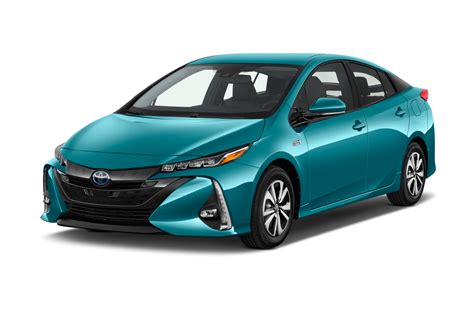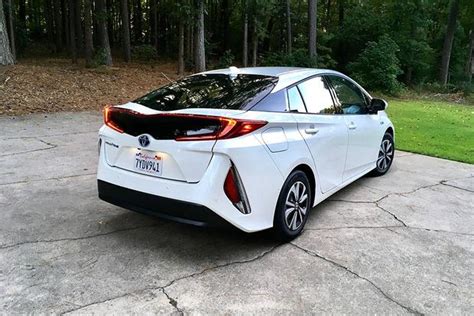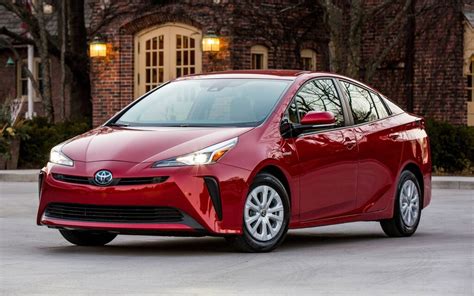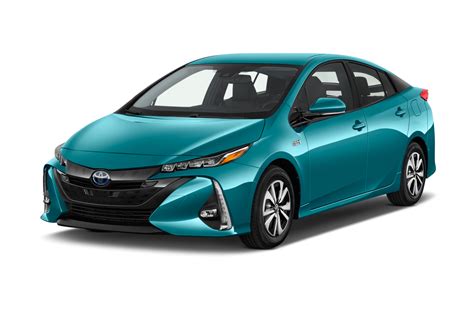2018 Toyota Prius prime problems

The Toyota Prius Plug-in Hybrid (often abbreviated as the Prius PHV and known as the Prius Prime in North America, South Korea, and New Zealand) is a plug-in hybrid liftback manufactured by Toyota. The first-generation model was produced from 2012 to 2016. The second-generation model has been produced since 2016. Production of the third-generation model began in 2023.
The Prius Plug-in Hybrid was the second most sold plug-in electric car in 2012, and became third-best all-time in December 2014. As sales declined after the end of its production, the Prius PHV fell to fifth place in the global ranking by November 2015, after being surpassed by both the Tesla Model S and the Mitsubishi Outlander PHEV. As of December 2017, sales were led by North America with 66,800 units, followed by Japan with 48,800, and the European market with 13,100 units. The U.S. was the leading country market with 65,703 units sold by 2017. As of December 2019, cumulative global sales of both Prius plug-in generations totaled 209,000 units.
Concept and demonstration models
The Prius Plug-In Hybrid Concept was exhibited at the September 2009 Frankfurt Motor Show, the October 2009 Tokyo Motor Show, and the December 2009 Los Angeles Auto Show. The vehicle was based on the third-generation Toyota Prius (model XW30) but outfitted with 5.2 kWh lithium-ion batteries. The selected battery capacity is the minimum required for a vehicle to be eligible for the U.S. federal tax credit of US$2,500, which under the American Clean Energy and Security Act of 2009 is applicable to the first 200,000 plug-ins sold by an automaker.
After displaying the concept version in these three shows, a global demonstration program involving 600 pre-production test cars began in late 2009 and took place in Australia, Canada, China, France, Germany, Japan, New Zealand and the United States. The demonstration vehicles were made available for lease to fleet and government customers, of which, 230 were delivered in Japan beginning in late December 2009, 125 in the U.S. by early 2010, and 200 in Europe in spring 2010. All program vehicles were equipped with data tracking devices to allow Toyota to monitor the car's usage for further development of the plug-in hybrid system.
The pre-production Prius Plug-in used three different batteries: two added batteries to provide all-electric drive and the standard hybrid battery which engages when the first two are depleted, allowing the car to operate like a regular hybrid Prius. According to Toyota, when the vehicle started, it operates in all-electric mode, drawing electrical power directly from the first battery pack. When the first battery was depleted, it disconnected from the circuit and the second pack engaged. When the second pack was depleted, it disconnected from the circuit and the vehicle defaulted to conventional hybrid mode, using the main battery as the sole electrical power source. Pack one and pack two would not reengage with the circuit until the vehicle was plugged in and charged.
According to Toyota, the demonstrator was rated at 1.76 L/100 km (134 mpg‑US; 161 mpg‑imp) on the Japanese JC08 cycle with a combined efficiency based on 43.6% of driving in EV mode, and CO2 emissions of 41 g/km. Fuel efficiency operating as a gasoline-electric hybrid, like the regular Prius, is 3.3 L/100 km (72 mpg‑US; 86 mpg‑imp) with CO2 emissions of 76 g/km.

Social links
Common 2018 Toyota Prius prime problems
The 2018 Toyota Prius Prime has been reported to have several common problems based on complaints from owners. Here are the details of those problems:
- Electrical Accessories Issues: Some owners have reported issues with electrical accessories, including the infotainment system, rear entertainment system, backup or other camera/sensors, head-up display, and microSD card for the GPS. The microSD card for the GPS was removed to show to the Toyota parts manager. When it came to time to reinstall the card, the car would not recognize the card. Toyota Service requests I have them troubleshoot the problem and I have not done this. The cost of keeping the GPS maps current is expensive and replacement of the microSD card is awkward and unreliable.
- Paint and Trim Issues: Some owners have reported issues with paint and trim, including cracked windshield that had to be replaced.
- EV Battery Issues: Some owners have reported issues with the EV battery, including starter battery needed to be jumped on a couple of occasions.
- In-car Electronics Issues: Some owners have reported issues with in-car electronics, including infotainment system (audio, GPS, phone), rear entertainment system, backup or other camera/sensors, head-up display. The microSD card for the GPS was removed to show to the Toyota parts manager. When it came to time to reinstall the card, the car would not recognize the card. Toyota Service requests I have them troubleshoot the problem and I have not done this. The cost of keeping the GPS maps current is expensive and replacement of the microSD card is awkward and unreliable.
- Windshield Cracks: Some owners have reported issues with the windshield, including windshield cracked in the 2019 Prius Prime, windshield cracks easily in the 2018 Prius Prime, and windshield chips and cracks easily in the 2017 Prius Prime.
- Rodent Damage: Some owners have reported issues with wires chewed by rodents in the 2017 Prius Prime.
These problems are based on complaints from owners and may not represent all 2018 Toyota Prius Prime vehicles. It's important to note that the Toyota Prius Prime is still considered a reliable vehicle, with many owners reporting no significant problems.

What are the most common problems on a 2018 Prius?
Top Toyota Prius Problems
- The Center Multi-Function Display May Fail. ...
- The Fuel Gauge May Read Incorrectly. ...
- Check Engine Light Due to Failed Three Way Coolant Control Valve. ...
- The Power Inverter Coolant Pump May Fail. ...
- Fuel Guage may not read correctly. ...
- Stalling or Loss of Power Due to Debris in Mass Air Flow Sensor.
How many years will the Prius Prime battery last?
Toyota Prius Hybrid Battery Life
The average battery life of a Toyota Prius is 8-10 years or around 150,000 miles. Regarding battery life, the Prius is one of the most reliable cars on the road. The hybrid battery is designed to maintain its charge over the car's life and should last as long as the car itself.
How many miles will a 2018 Prius last?
With regular maintenance, a Toyota Prius owner can expect to get between 200,000 and 250,000 miles out of their Prius, with some owners topping the 300,000-mile mark and going strong.
What is the most common problem of Toyota Prius?
A list of some of the most common issues Prius owners have to deal with.
- Bluetooth Echos During Calls. ...
- Musty and Moldy A/C. ...
- Unintended Acceleration. ...
- Rodents Chew Soy-Coated Wires. ...
- Prius Headlight Problems. ...
- Prius Brake Defects. ...
- Toyota Excessive Oil Consumption.
What are the most common problems on a 2018 Prius?
Owner Reported Trouble Spots
- Exhaust. Muffler, pipes, catalytic converter, exhaust manifold, heat shields, leaks. ...
- Electrical Accessories. ...
- Paint And Trim. ...
- EV Battery. ...
- Brakes. ...
- Steering And Suspension.
What is the most common problem of Toyota Prius?
A list of some of the most common issues Prius owners have to deal with.
- Bluetooth Echos During Calls. ...
- Musty and Moldy A/C. ...
- Unintended Acceleration. ...
- Rodents Chew Soy-Coated Wires. ...
- Prius Headlight Problems. ...
- Prius Brake Defects. ...
- Toyota Excessive Oil Consumption.
What is the fuel economy of a 2018 Prius Prime L 100km?
Toyota estimates the Prius Primes fuel consumption at 4.3/4.4 L/100 km (city/highway), while electric energy use is 1.8Le/100 km combined.
How many miles will a 2018 Prius last?
With regular maintenance, a Toyota Prius owner can expect to get between 200,000 and 250,000 miles out of their Prius, with some owners topping the 300,000-mile mark and going strong.
2018 Toyota Prius prime car problems categorized by type of issue
After analyzing all complaints sent to the NHTSA and researching popular Toyota Prius prime problems, we found that the most common problems with these 2023 model year vehicles are:
- Unknown or other problems
- Air bags problems
- Fuel/propulsion system problems
- Structure problems
- Vehicle speed control problems
The graph below shows statistics for all 2018 Toyota Prius prime vehicle components and the number of complaints received.
2018 Toyota Prius prime complaints
The NHTSA has received 11 complaints about various vehicle components related to the 2018 Toyota Prius prime.
STRUCTURE,VEHICLE SPEED CONTROL,UNKNOWN OR OTHER PROBLEM
- Date Of Incident: 2023-10-21
- Crash: 1
- VIN: JTDKARFPXJ3
- Components: STRUCTURE,VEHICLE SPEED CONTROL,UNKNOWN OR OTHER
- Summary: My 2018 Toyota Prius Supreme was parked too far away from the curb in front of a house where we were invited, in a residential area in Naperville IL. I entered the car to park it properly. I had my foot on the brakes and pressed the starting button for the engine to turn on. I then put the car on reverse and suddently the car accelerated uncontollably. Went on the grass, hit the neighbor's mailbox and stopped by crashing on a tree. I was in shock but luckily not injured. Other guests were present and witnessed the incident. Police was called in and issued a report. The car was declared by Progressive Insurance Co as a total loss.
AIR BAGS PROBLEM
- Date Of Incident: 2023-08-03
- Number Of Injuries: 2
- Crash: 1
- VIN: JTDKARFPXJ3
- Components: AIR BAGS
- Summary: Airbags deployed prematurely as I was parking my car in a doctor's office parking lot. The car was going less than 5 mph and I did not hit anything. The premature deployment of the airbag startled me and caused me to hit the accelerator instead of the brake and I ended up crashing my car into a nearby pole and another .automobile. The accident resulted in a soft tissue injury for my daughter and I'm experiencing lower back pains. The air bag caused burns on my nose and arms. My daughter has bruising on the arms from the air bag deployment
POWER TRAIN PROBLEM
- Date Of Incident: 2023-04-14
- VIN: JTDKARFP3J3
- Components: POWER TRAIN
- Summary: Take foot of break, car accelerates under power. Sooner or later, this is going to result in killing a pedestrian. The question has been for the last year, is this a behavior that can be gotten used to. The answer is definitely NO! This resulted in a near collision with a pedestrian today. Toyota believes the behavior is intentional and will not confirm the safety issue. Farmers Insurance is willing to believe the issue exists without inspection but has no idea what to do. You have a problem on your hands. Biden is trying to transition almost everybody away from gasoline vehicles; thus those that drive manual transmissions will be driving electric vehicles, and their brain patterns have not changed and the procedure for getting rolling from a dead stop will be done the old way, and it's now dangerous. In a manual transmission it is necessary to transition off the break before completing looking all three ways (left, right, straight) because the transition time from break to power is so long that if the looking is done before, it is out of date by the time power is being applied. Applying the same procedure to an electric car has potentially lethal results; and people who have been driving a manual transmission for a long time will end up using its procedure in an electric car by habit. Perhaps you observed the reports over the last few decades of old men with new cars having unintended acceleration problems with no cause found. I now believe that a number of these have a very similar explanation. Car isn't off, take foot of break to get out of car, car accelerates. In an electric car, telling the car isn't off isn't very easy any more. This is easy to understand. An automatic transmission vehicle has an unremovable dumb behavior where take foot off break accelerates, whereas in a manual transmission this stalls, which is a safer result. There is no reason this behavior should carry over to computer drive, including electric or hybrid vehicles.
AIR BAGS PROBLEM
- Date Of Incident: 2023-01-11
- Number Of Injuries: 1
- Crash: 1
- VIN: JTDKARFP6J3
- Components: AIR BAGS
- Summary: Air bag did not deploy during a head on collision at 25-30 mph. No warning lamps. Car is totaled according to tow truck driver. Currently at the body shop, waiting for adjusters approval for body shop to take car apart to assess the damage.
SERVICE BRAKES PROBLEM
- Date Of Incident: 2022-08-31
- Crash: 1
- VIN: JTDKARFP4J3
- Components: SERVICE BRAKES
- Summary: The contact owns a 2018 Toyota Prius. The contact stated while driving approximately 5 MPH and in heavy traffic, the contact depressed the brake pedal for traffic but the brakes failed. The contact stated no warning light was illuminated. The contact crashed into the rear end of a truck. The damage was very light due to the low speed. The top of the hood at the front was scratched and the grill also sustained minor scratches. The contact continued on the road. The contact had taken the vehicle to a local dealer, who contacted a manufacturer representative to diagnose the vehicle. The contact was advised that there was no brake failure. The vehicle had not been repaired. The manufacturer had been informed of the failure. The failure mileage was 40,063.
BACK OVER PREVENTION,FORWARD COLLISION AVOIDANCE PROBLEM
- Date Of Incident: 2018-11-15
- VIN: JTDKARFP0J3
- Components: BACK OVER PREVENTION,FORWARD COLLISION AVOIDANCE
- Summary: From the first week of ownership sensors would alarm that they needed cleaning but they were clean. Parking assist sensors also malfunctioning. Also saw Intelligent Clearance Sonar error messages and warnings. Alarm tended to go off in wet weather. Brought to dealership many times and problem occurred infrequently that no problem was ever found. For two years I was plagued by alarms of sensor malfunction. I worried the sensors would fail to detect cars and objects in front of, behind or on the side of the car. That would be a serious failure and cause of an accident. After two years of unsuccessful testing, I traded in the car.
EXTERIOR LIGHTING PROBLEM
- Date Of Incident: 2021-01-28
- VIN: JTDKARFP4J3
- Components: EXTERIOR LIGHTING
- Summary: WHILE DRIVING ON RURAL ROADS WITH NO STREET LIGHTS, THE AUTOMATIC HIGH BEAM SYSTEM MALFUNCTIONS WHEN PASSING ONCOMING TRAFFIC WHO DO NOT DIM THEIR HEADLIGHTS OR WHO HAVE THOSE HEADLIGHTS THAT SHOULD BE ILLEGAL (LIKE FORD). NORMAL LOW-BEAM HEADLIGHTS DO NOT CAUSE THE SYSTEM TO MALFUNCTION. I BELIEVE THIS MALFUNCTION TO BE RELATED TO THE CAMERA SENSOR LOCATED ON THE WINDSHIELD AND WHEN THE GLARE OF THE EXCESSIVELY BRIGHT HEADLIGHTS HIT THAT SENSOR, IT CRASHES THE AUTO SYSTEM. THE SYMBOL ON THE DASH THAT INDICATES THAT THE SYSTEM IS WORKING NORMAL CUTS OFF FOR APPROXIMATELY 25-30 SECONDS, DURING WHICH TIME THE HIGH BEAMS WILL NOT ENGAGE. AFTER THAT 30 SECOND DELAY, THE SYSTEM REBOOTS, THE LIGHT ON THE DASH COMES BACK ON AND THE HIGH BEAMS RE-ENGAGE. THIS IS DANGEROUS AS ALL MANNER OF WILDLIFE CROSS THAT ROAD AT NIGHT AND WITHOUT BRIGHT LIGHTS, MY REACTION TIME IS CUT IN HALF. I HAVE TALKED TO THE TOYOTA DEALERSHIP ABOUT THIS ISSUE SINCE I PURCHASED THIS CAR IN MAY OF 2019 TELLING THEM THERE IS A MALFUNCTION IN THE SYSTEM, AND WAS INITIALLY INFORMED THAT THIS WAS NORMAL FUNCTIONALITY. I OWNED A 2017 PRIUS PRIME ADVANCED (ONE YEAR OLDER THAN THIS ONE) AND IT NEVER MALFUNCTIONED, SO I KNOW THIS IS A MALFUNCTION IN THE SYSTEM. AFTER SPEAKING WITH THE SERVICE MANAGER IN DEPTH ABOUT MY EXPERIENCE WITH THIS ISSUE, HE FINALLY UNDERSTOOD THAT THIS IS AN ISSUE AND NOT NORMAL FUNCTIONALITY. THEY HAVE KEPT MY CAR SEVERAL TIMES TRYING TO RECREATE THE FAILURE, BUT UNLESS THEY DRIVE OUT IN THE MIDDLE OF NOWHERE (SUPER DARK) AND COME ACROSS SOMEONE WITH "TOO-BRIGHT" HEADLIGHTS, IT IS UNLIKELY THEY WILL ACCOMPLISH A FAILURE. I WAS ALSO TOLD THAT TOYOTA DID NOT KNOW ANYTHING ABOUT THIS ISSUE. I HAVE SINCE DONE THE RESEARCH AND FOUND THAT THIS HAS BEEN AN ISSUE SINCE AT LEAST 2017, AND OCCURS ON VARIOUS TOYOTA MODELS (PRIUS, AVALON, RAV4, ETC...). I HAVE VIDEO OF THE FAILURE.
FUEL/PROPULSION SYSTEM PROBLEM
- Date Of Incident: 2021-01-11
- VIN: JTDKARFPXJ3
- Components: FUEL/PROPULSION SYSTEM
- Summary: SUPPLEMENT TO COMPLAINT # 11384074 THE VEHICLE HAD THE SAME PROBLEM ON JANUARY 11 AND 12, 2021 AT APPROXIMATELY 7 AM. SPEED WAS 76 MPH, AND THE FUEL DEPRIVATION OCCURRED FOR 8-10 SECONDS EACH TIME. THE VEHICLE HAS NEVER HAD THE PROBLEM GOING HOME AT 2 PM.
ENGINE PROBLEM
- Date Of Incident: 2020-12-01
- VIN: JTDKARFPXJ3
- Components: ENGINE
- Summary: AFTER THE HYBRID BATTERY IS DISCHARGED, AND THE GAS ENGINE KICKS IN, THE VEHICLE LOSES POWER FOR APPROXIMATELY 5-10 SECONDS ON THE FREEWAY. THIS HAS HAPPENED FOUR TIMES, AT APPROXIMATELY 7 AM, ON DECEMBER 1, 10, 14 AND 15. ON ALL OCCASIONS, THE TEMPERATURE WAS BETWEEN 40-45 DEGREES FAHRENHEIT, AND AT HIGHWAY SPEEDS. THE CRUISE CONTROL WAS NOT IN USE. NO WARNING LIGHTS CAME ON. I CALLED THE TOYOTA DEALER ON DECEMBER 1 AND THE SERVICE ADVISER SAID THAT SINCE NO WARNING LIGHTS CAME ON, HE COULD NOT DETERMINE THE PROBLEM. I HAVE A PHOTO SHOWING MY CONTACTING THE TOYOTA DEALER ON DECEMBER 1ST. ON DECEMBER 10, I TOOK THE VEHICLE INTO TOYOTA IN THE AFTERNOON. THE DEALER CHECKED THE VEHICLE AND ROAD TESTED THE VEHICLE WITHOUT HAVING THE HYBRID BATTERY CHARGED, AND THE AIR TEMPERATURE WAS WARMER. I WAS CHARGED $210 FOR THE DIAGNOSTIC SERVICE, ALTHOUGH I HAVE AN EXTENDED WARRANTY. THE SAME PROBLEM OCCURRED ON DECEMBER 14 AND 15. SPECIFIC PROBLEM UNKNOWN BUT I BELIEVE THAT A SWITCH THAT CONTROLS THE GASOLINE VOLUME INTO THE ENGINE AFTER THE HYBRID BATTERY POWER IS DEPLETED IS DEFECTIVE. I WAS IN THE CARPOOL LANE AT APPROXIMATELY 7 AM ON ALL 4 OCCASIONS AND MY SPEED DROPPED, ALTHOUGH I DEPRESSED THE GAS PEDAL TO MAXIMUM AS WELL AS PUMPING THE GAS PEDAL, ALL TO NO AVAIL. THE CAR IS IN USE ONLY MONDAY, TUESDAY, WEDNESDAY AND THURSDAY, THE DAYS THAT I WORK. I CONTACTED TOYOTA CUSTOMER ADVOCATE (800-331-4331, CASE # 2012120505) AND THEY SAID THEY DID NOT HAVE THE ABILITY TO DETERMINE IF ANYONE ELSE EVER HAD THE SAME PROBLEM.
ELECTRICAL SYSTEM,FUEL/PROPULSION SYSTEM PROBLEM
- Date Of Incident: 2020-11-10
- VIN: JTDKARFP3J3
- Components: ELECTRICAL SYSTEM,FUEL/PROPULSION SYSTEM
- Summary: 'HYBRID SYSTEM FAILURE' APPEARED ON DASH DISPLAY DURING A LONG (120 MILE) DRIVE AT HIGHWAY SPEED ON SEPTEMBER 24. AFTER DRIVING ABOUT 40 MILES FURTHER, THE 'CHECK ENGINE LIGHT' CAME ON AND THE DISPLAY SAID TO PULL OVER IMMEDIATELY. AS I PULLED OFF THE FREEWAY, MESSAGES TOLD ME THE POWER STEERING AND POWER BRAKES WERE SHUTTING OFF AND LEFT ME IN FEAR THE CAR WOULD DIE ON THE FREEWAY RAMP BEFORE I COULD PULL OVER. TOWED CAR TO DEALER WHO FIXED A LOOSE CABLE. THIS WEEK (11/10) THE DISPLAY SHOWED THE SAME MESSAGE. THIS IS NOW A RECURRING PROBLEM WITH THIS MODEL.
UNKNOWN OR OTHER PROBLEM
- Date Of Incident: 2020-02-06
- VIN: JTDKARFP8J3
- Components: UNKNOWN OR OTHER
- Summary: AFTER STARTING FROM A STOP AFTER THE TRAFFIC LIGHT TURNED GREEN, THE CAR IN FRONT OF ME PULLED AHEAD AS THEY ACCELERATED FASTER THAN ME. WHEN THE CAR IN FRONT OF ME WAS ABOUT 50 YARDS IN FRONT OF ME, AND I HAD REACHED ABOUT 25 MILES PER HOUR THE CAR'S COLLISION AVOIDANCE SYSTEM ENGAGED AND SLAMMED ON THE BRAKES AND BROUGHT ME TO A FULL STOP. THE CAR IN FRONT OF ME HAD NOT APPLIED THEIR BRAKES OR SLOWED AT ALL, AND THERE WERE NO VISIBLE OBSTACLES. MY CAR STOPPED SO SUDDENLY THAT I THOUGHT I HAD BEEN HIT FROM THE REAR AT HIGH SPEED UNTIL THE RED WARNING LIGHTS APPEARED ON THE DASH (AFTER THE BRAKING STARTED). THE CARS BEHIND ME ALMOST RAN INTO ME BECAUSE OF THE SUDDEN STOP.
Negative 2018 Toyota Prius prime car reviews
Positive 2018 Toyota Prius prime car reviews
-

Although the cargo room is not the most spacious, I have had no problem loading many boxes into it. The seats can be folded down to fit a bit more, but usually it is not necessary. The car accelerates great in EV mode, but it is not the best in hybrid mode once the battery is depleted. The back seat fits a car seat just fine with enough room for me to drive comfortably. The ride is okay, but it can be a bit noisy sometimes and I can feel the big bumps, which is expected in a small car. The lights are super bright and the high beams are even better. In the winter (under 32°F), I get 21 miles on the highway (65-70mph) in EV only and 25 miles if I use non-highway (55 mph) roads. I can get to and from work in EV only if I charge at work, even though I live 21 miles from the office and 95% of my commute is on the highway. In the summer (50-80°F), I get nearly 30 miles and about 54 mpg using hybrid mode on the highway (65 mph). I highly recommend this car.
-

I really love this car! With 1500 miles on it, I'm averaging 104 MPG, which is amazing. Living in a rural area, I often have to travel 10 to 15 miles to get to other small towns, but luckily I have a 240V line and charger, so I can easily recharge in just 2 hours. Even when I travel to larger cities, which are about 100 miles away from my home, my car performs exceptionally well. My friend has a Volt, and although he has a longer battery range, he gets much worse mileage when his battery is depleted compared to my Prime. In fact, he is getting approximately 20 MPG's less than I am. When we travel together, his kids always ask to take my car since it has much better rear passenger room. The car is quiet, dependable, handles well, and is an excellent buy when you consider the state tax rebate and federal tax credit. I would definitely buy this car again with no hesitation.
-

This car is perfect for those who don't travel far, like an elderly retired couple or working stiffs with a short commute. With a range of 25 miles, we've found that we can go even further with mostly low speed and non-highway driving. Plus, we've hardly used any gas in the seven months we've owned it. We chose the Prime not just for its gas-saving capabilities, but also to experience the latest technology at an affordable price. While we couldn't afford a Tesla or Bolt, we're just as happy with our Prime after nearly two years of ownership. The only issue we had was a faulty charging cable, but Toyota took care of it under warranty.
-

With an overall MPG average of 77.3 and 87,610 miles, this car is a joy to drive. Despite the uncomfortable front seats, it has proven to be a reliable vehicle with impressive safety features. Although I was disappointed to discover that it does not come with a spare tire, I have only experienced one flat tire. If I were to purchase a new car, I would consider the RAV4 model for its larger battery and greater EV cruise range. As someone who has previously owned a 2004 Prius with 267,000 miles, I can confidently say that I would purchase this vehicle again.
-

I bought the PRIUS Prime to have a fuel-efficient car for my daily commute. I am happy to report that it has exceeded my expectations in terms of fuel economy, with an average MPG of 57 in hybrid mode and 35 miles in electric mode. It's exactly what I was looking for! However, there are a few areas where the PRIUS falls short. For example, it only has a single zone climate control, the large computer screen can be difficult to see in certain sun angles, and the sun visor doesn't extend out when rotated to the door window. Additionally, acceleration is a bit slow and the engine can be quite loud when accelerating. Lastly, there is limited storage space in the hatchback. Despite these minor issues, I am still very satisfied with my purchase.
Additional sources
More sources of information about 2018 Toyota Prius prime problems:

Any problems experienced with the 2019 Prius Prime? : r/PriusPrime
Dec 7, 2022 ... Brake booster and head gaskets were an issue with 3rd gen. Some Early years of the 4th gen and Prime had coolant loss from a leak into the ...
2018 Toyota Prius Prime Problems | Kelley Blue Book
How reliable is the 2018 Toyota Prius Prime? See the most common repairs performed and learn if your vehicle is at risk for major repairs in the next 12 ...
2018 Prius Prime EV battery problem | PriusChat
But when this sudden drop in the ACTUAL EV range happens in absence of any common causes listed and persists even after eliminating all the ...
2018 Toyota Prius Reliability - Consumer Reports
Owner Reported Trouble Spots · Exhaust · Electrical Accessories · Paint And Trim · EV Battery · Brakes · Steering And Suspension · Engine Major · Electric Motor.
2018 Prius Prime Adv Navigation issues | PriusChat
Sad to tell you, but all of what you mentioned are well known "defects" of Toyota's in-car navi system. "Defects" in a sense of normal operator ...
Other years of Toyota Prius prime






Are you having problems with your 2018 Toyota Prius prime?



Gerhard Williamson 2025-01-10
This car has the most road noise out of any car I've owned, and the low beam headlights are terrible. However, the lane departure warning is nice, and the seats are typically Toyota - very supportive and comfortable. The fit and finish are typical Toyota perfection. Overall, I believe this is the most reliable and affordable EV on the market, although it should be noted that it is not a luxury car.
Kaleigh Rodriguez 2024-04-05
Hi there! I hope you're doing well. I wanted to share my experience with my 2018 Toyota Prius that I purchased in February 2019. I've driven about 6 thousand miles so far, but unfortunately, I had an accident 4 weeks ago due to unintended acceleration. It was a scary experience, but thankfully no one was hurt. Since then, I've been trying to get in touch with Toyota to investigate the case, but they have been quite slow in responding. I'm still waiting to hear from them. I understand that these types of complaints can take some time to resolve, but I was surprised by how bureaucratic Toyota has been in dealing with the case. As you may know, Toyota sells 3 million vehicles in North America every year, so I had high hopes for their customer service. I'll keep you posted on any developments every week. Thanks for listening!
Darrion Crooks 2024-03-18
I noticed that the front scoop bumper configuration may not be to everyone's liking as it may be prone to scratches and dings. The driver's seat has a lot of features and can be overwhelming at first, but I believe one would get used to it over time. Unfortunately, the rear visibility is not the best and could potentially be a safety issue. On a positive note, the car has great gas mileage, comfortable seats, and a spacious cargo/trunk. Overall, it seems like a great car with some minor drawbacks.